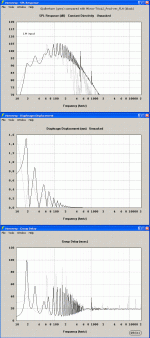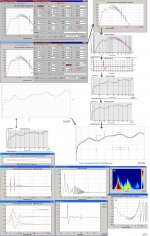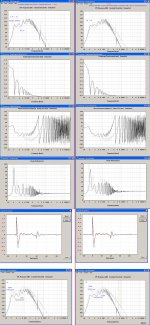bleh,
and you continue to prove unable to answer *the asked question*
if we left a reasonable man in a woodshop with some tools and drivers and asked him to build a subwoofer horn, using his best guesses/skills, and he did so, he would create a horn based subwoofer, a few hours listening and tweaking the design and he may even have something quite good.
you would have nothing, you would offer multiple reasons why it was not worth picking up any tools.
Then you have everything you need. You've got a 5.5" driver that puts out 'amazing bass' You've got a quad of 8" drivers you put in a cabinet that looks like a carlson... You obviously have tools and wood available.
You do not need to ask any questions on this forum because you have everything you need, so please stop.
you asked me to never build one of your designs, i havent
i asked you to stop posting in my threads, but you continue,
your a
'do as i say not as i do'
type arn't you mr bell?
i asked you to stop posting in my threads, but you continue,
your a
'do as i say not as i do'
type arn't you mr bell?
Then you have everything you need. You've got a 5.5" driver that puts out 'amazing bass' You've got a quad of 8" drivers you put in a cabinet that looks like a carlson... You obviously have tools and wood available.
You do not need to ask any questions on this forum because you have everything you need, so please stop.
Last edited:
im sure if i/someone took a design like this
http://www.cowanaudio.com/images/30Hz Tapped Horn_2.gif
and left the middle panel unglued, and experimented with angle of that panel some fun could be had.
http://www.cowanaudio.com/images/30Hz Tapped Horn_2.gif
and left the middle panel unglued, and experimented with angle of that panel some fun could be had.
bleh,
and you continue to prove unable to answer *the asked question*
If you had used all that time you have been on here, to learn Hornresp instead of asking questions, you would have been making sawdust by now.
You are clearly not in to learning, only to get answers.
Dag
ehm....please take a look at transflex before going on like this...
I think could solve your problem...
now I will disappear and leave you alone...XD just a little intrusion😛
I think could solve your problem...
now I will disappear and leave you alone...XD just a little intrusion😛
different people learn in different ways, there is more then 1 way to learn things,
clearly you have not learned this.
clearly you have not learned this.
If you had used all that time you have been on here, to learn Hornresp instead of asking questions, you would have been making sawdust by now.
You are clearly not in to learning, only to get answers.
Dag
IMO: I believe you seriously underestimate the task at hand. Even the horns I remember from my youth (50's,60's) required R&D and evaluation....if you had no way to measure a speakers ts params,, and no way to calculate a horns response, but using all you know about what might work and what to avoid.
The ability to measure the transducer parms. is paramount. As is the acoustic response measurement. It is far less expensive than it used to be.
I understand what your saying and,
we all have 2 extraordinary measuring devices, and i trust mine more then any microphone or computer.
we all have 2 extraordinary measuring devices, and i trust mine more then any microphone or computer.
The ability to measure the transducer parms. is paramount. As is the acoustic response measurement. It is far less expensive than it used to be.
lets say thee was $10,000 to be won in a competition 🙂
if you had no way to measure a speakers ts params,, and no way to calculate a horns response, but using all you know about what might work and what to avoid.
The person who wins the competition will be one who has done it before, and if you reverse engineer the result, the math will work out to be correct.
Why? Because trial and error is one method of doing math. You measure, perhaps using you ears, and keep itertaing toward a solution until the residual error - the difference between the actual response and the desired one - gets small enough to ignore or live with. The first solution is not the right one, but the 50th might be. Some of the most advanced simulation programs use this method to solve simultaneous equations with many unkowns - it's called an "optimizer".
 you have suggested 2 different designs
you have suggested 2 different designs Hi 60ndown,
Well, I'd take somebody elses work product, and copy it. 🙂
Regards,
Hi 60ndown,
Take the sketch in Post #10 and this one (same basic box), and start experimenting. 15", 18", 4x10" just see what it sounds like, and if you like it. Then let us know the results. 🙂
Regards,
...You just can't leave out mwmkravchenko's Trio12 FLH:
http://www.diyaudio.com/forums/subwoofers/168697-trio-12-front-loaded-horn-subwoofer.html...
Hi,
Late post as usual😀
I would put the Gjallerhorn way ahead of the Trio12 design and even a design using another driver: E.g. the 10" Peerless 830452 using the Trio box.
First submitted picture: Gjallerhorn versus the 168697-trio-12-front-loaded-horn-subwoofer.
Second picture and further on: Trio12 FLH 🙂eek: IMO odd driver choice) and comparisons if using the 10" Peerless driver instead.
b 🙂
Attachments
-
 Gjallerhorn-versus_Mkrav-Trio12_Prod-ver_FLH.GIF71.4 KB · Views: 148
Gjallerhorn-versus_Mkrav-Trio12_Prod-ver_FLH.GIF71.4 KB · Views: 148 -
 0-Trio-12-front-loaded-horn-subwoofer.JPG759 KB · Views: 166
0-Trio-12-front-loaded-horn-subwoofer.JPG759 KB · Views: 166 -
 1-Trio-12-front-loaded-horn-subwoofer.GIF145.7 KB · Views: 152
1-Trio-12-front-loaded-horn-subwoofer.GIF145.7 KB · Views: 152 -
 2-Peerless-in-Trio-enclosure.GIF146.3 KB · Views: 148
2-Peerless-in-Trio-enclosure.GIF146.3 KB · Views: 148 -
 3-Peerless-in-Trio-mod-enclosure.GIF145.9 KB · Views: 133
3-Peerless-in-Trio-mod-enclosure.GIF145.9 KB · Views: 133 -
 1-Comp.GIF119.6 KB · Views: 91
1-Comp.GIF119.6 KB · Views: 91 -
 2-Comp.JPG512.3 KB · Views: 86
2-Comp.JPG512.3 KB · Views: 86
thank you,
im just trying to 'optimize' how few iterations i actually have to try, by implementing some basic horn theory before i get my saw out 🙂
im just trying to 'optimize' how few iterations i actually have to try, by implementing some basic horn theory before i get my saw out 🙂
The person who wins the competition will be one who has done it before, and if you reverse engineer the result, the math will work out to be correct.
Why? Because trial and error is one method of doing math. You measure, perhaps using you ears, and keep itertaing toward a solution until the residual error - the difference between the actual response and the desired one - gets small enough to ignore or live with. The first solution is not the right one, but the 50th might be. Some of the most advanced simulation programs use this method to solve simultaneous equations with many unkowns - it's called an "optimizer".
im just trying to 'optimize' how few iterations i actually have to try, by implementing some basic horn theory before i get my saw out 🙂
basic horn theory = math
basic horn theory = math
Because trial and error is one method of doing math, if you reverse engineer the result, the math will work out to be correct.
you'r way is not the only way mr bell.
I'm curious to see your results! Please take pictures.
Because trial and error is one method of doing math, if you reverse engineer the result, the math will work out to be correct.
you'r way is not the only way mr bell.
Because trial and error is one method of doing math, if you reverse engineer the result, the math will work out to be correct.
you'r way is not the only way mr bell.
If you had written him a letter with a pen to ask what methods you could use to construct a horn using trial and error I'm sure the response would be less edgy, however considering you're asking hypothetical questions about speaker design that abandon modern tools (and even more inane, abandon the very tool you're using to ask the question, your computer,) you can't possibly expect that the outcome will be constructive.
Now consider how reasonably one could come to think that this is trolling, as are 5/7 of your threads that are currently on the front page.
The entire idea of trial and error design is to try without guidance and continue to fail until you succeed. If you have to ask the best way to do trial and error, then it isn't trial and error anymore, it's a 🤐 'n plan.
You obviously have a computer. If your intent is to do pure trial and error research, take your computer outside and back over it with your car a few times then go into your garage and do trial and error.
- Status
- Not open for further replies.
- Home
- Loudspeakers
- Subwoofers
- 60ndown's Merged Subwoofer Thread
